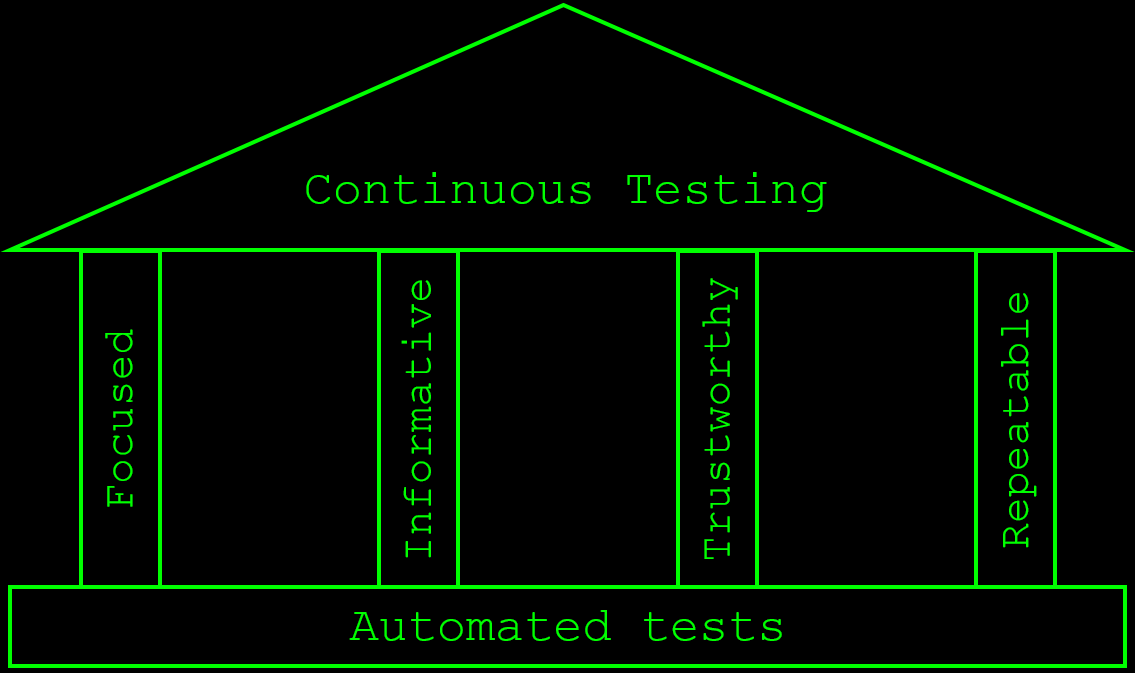On supporting Continuous Testing with FITR test automation (republished)
This post was published on September 7, 2018Note: this is an updated version of an earlier post I wrote in May of last year. Since then, my understanding of Continuous Testing and what it takes for automation to be a successful and valuable part of any Continuous Testing effort have changed slightly, so I thought it would be a good idea to review and republish that post.
Test automation is everywhere, nowadays. That’s probably nothing new to you.
A lot of organizations are adopting Continuous Integration and Continuous Delivery as a means of being able to develop and deliver software in ever shorter increments. Also nothing new.
To be able to effectively implement CI/CD, a lot of organizations are relying on their automated tests to help safeguard quality thresholds while increasing release speed. Again, no breaking news here.
However, automation in and by itself isn’t enough to safeguard quality in CI and CD. You’ll need to be able to do Continuous Testing (CT). Here’s how I define Continuous Testing, a definition greatly influenced by others that have been talking and writing about CT for a while:
Continuous Testing is the process that allows you to get valuable insights into the business risks associated with delivering application increments following a CI/CD approach. No matter if you’re building and deploying once a month or once a minute, CT allows you to formulate an answer to the question ‘are we happy with the level of value that this increment provides to our business / stakeholders / end users? ‘ for every increment that’s being pushed and deployed in a CI/CD approach.
It won’t come as a surprise to you that automated tests often form a significant part of an organization’s CT strategy. However, just having automated tests is not enough to be able to support CT. Apart from the fact that automation can only do so much (a topic I’ve discussed in several other blogs and articles), not every bit of automation is equally suitable to be used in a CT strategy. But how do you decide whether or not your automation can be used as part of your CT efforts? And when they can’t, what do you need to take care of to improve them?
In order to be able to leverage your automated tests successfully for supporting CT, I’ve come up with a model based on four pillars that need to be in place for all automated checks before they can become part of your CT process:

Let’s take a quick look at each of these FITR pillars and how they are necessary when including your automation into CT.
Focused
Automated tests need to be focused to effectively support CT. ‘Focused’ has two dimensions here.
First of all, your tests should be targeted at the right application component and/or layer. It does not make sense to use a user interface-driven test to test application logic that’s exposed through an API (and subsequently presented through the user interface), for example. Similarly, it does not make sense to write API-level tests that validate the inner workings of a calculation algorithm if unit tests can provide the same level of coverage.
The second aspect of focused automated tests is that your tests should test what they can do effectively. This boils down to sticking to what your test solution and tools in it do best, and leaving the rest either to other tools or to testers, depending on what’s there to be tested. Don’t try and force your tool to do things it isn’t supposed to (here’s an example).
If your tests are unfocused, they are far more likely to be slow to run, to have high maintenance costs and to provide inaccurate or shallow feedback on application quality.
Informative
Touching upon shallow or inaccurate feedback, automated tests also need to be informative to effectively support CT. ‘Informative’ also has two separate dimensions.
Most importantly, the results produced and the feedback provided by your automated tests should allow you, or the system that’s doing the interpretation for you (such as an automated build tool), make important decisions based on that feedback. Make sure that the test results and reporting provided contain clear results, information and error messages, targeted towards the intended audience and addressing business-related risks. Keep in mind that every audience has its own requirements when it comes to this information. Developers likely want to see stack traces, whereas managers don’t. Find out what the target audience for your reporting and test results is, what their requirements are, and then cater to them as best as you can. This might mean creating more that one report (or source of information in general) for a single test run. That’s OK.
Another important aspect of informative automated tests is that it should be clear what they do (and what they don’t do), and what business risk they address. You can make your tests themselves be more informative through various means, including (but not limited to) using naming conventions, using a BDD tool such as Cucumber or SpecFlow to create living documentation for your tests, and following good programming practices to make your code better readable and maintainable.
When automated test solutions and the results they produce are not informative, valuable time is wasted analyzing shallow feedback, or gathering missing information, which evidently breaks the ‘continuous’ part of CT.
Trustworthy
When you’re relying on your automated tests to make important decisions in your CT activities, you’d better make sure they’re trustworthy. As I described in more detail in previous posts, automated tests that cannot be trusted are essentially worthless. Make sure to eliminate false positives (tests that report a failure when they shouldn’t), but also false negatives (tests that report no failure when they should).
Repeatable
The essential idea behind CT (referring to the definition I gave at the beginning of this blog post) is that you’re able to give insight into application quality and business risks on demand, which means you should be able to run your automation on demand. Especially when you’re including API-level and end-to-end tests, this is often not as easy as it sounds.
There are two main factors that can hinder the repeatability of your tests:
- Test data. This is in my opinion one of the hardest ones to get right, especially when talking end-to-end tests. Lots of applications I see and work with have complex data models or share test data with other systems. And if you’re especially lucky, you’ll get both. A solid test data strategy should be put in place to do CT, meaning that you’ll either have to create fresh test data at the start of every test run or have the ability to restore test data before every test run. Unfortunately, both options can be quite time consuming (if at all attainable and manageable), drawing you further away from the ‘C’ in CT instead of bringing you closer to it.
- Test environments. If your application communicates with other components, applications or systems (and pretty much all of them do nowadays), you’ll need suitable test environments for each of these dependencies. This is also easier said than done. One possible way to deal with this is by using a form of simulation, such as mocking or service virtualization. Mocks or virtual assets are under your full control, allowing you to speed up your testing efforts, or even enable them in the first place. Use simulation carefully, though, since it’s yet another moving part of your CT solution to be managed and maintained, and make sure to test against the real thing periodically for optimal results.
Having the above four pillars in place does not guarantee that you’ll be able to perform your testing as continuously as your CI/CD process requires, but it will likely give it a solid push in the right direction.
"